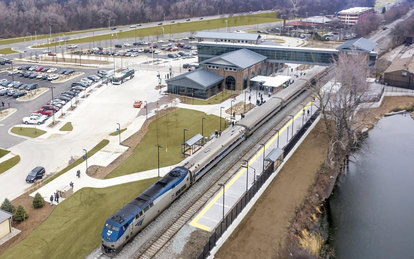John D. Dingell Transit Center Begins Operation

The new $28.2 million John D. Dingell Transit Center has begun operation in Dearborn, Michigan, positioning the city as a pivotal player in transit connections within southeast Michigan and throughout the region. Planning and design of the project was the result of a collaboration of SmithGroup and Neumann/Smith Architecture.
The new, 16,000-square-foot, two-story transit center, named after former U.S. Congressman John Dingell, Jr., replaces a smaller passenger rail station that dated back to the 1970s. The new center now connects passengers to Amtrak’s Wolverine service, extending from Pontiac to Chicago, and also links to SMART, DDOT and Greyhound buses; corporate and hotel shuttles; taxis; and non-motorized greenways for bicyclists and pedestrians. The project was made possible by a $28.2 million grant from the American Recovery and Reinvestment Act.
SmithGroup served as landscape architect and civil engineer for the project, working with the City of Dearborn to select the transit center site, manage the environmental clearance stage and prepare a transit-oriented development (TOD) plan for West Dearborn.
“From the very beginning, Dearborn’s goals for the location of the new transit facility were all about connectivity,” said Patrick Doher, PE, SmithGroup principal-in-charge. “The location needed to serve as a gateway and provide regional connection to the city’s great assets, the non-motorized greenway system, businesses and residential neighborhoods.”
In addition to connectivity, the transit center also needed to be a catalyst for economic growth. With opportunities for transit-oriented development and partnerships with private enterprises in the community, its location on Michigan Avenue and adjacent to The Henry Ford met all of those goals.
Neumann/Smith Architecture, Southfield, Michigan, led the multidisciplinary design team during the preliminary and final architectural design phases, including all necessary systems, rail side improvements, platforms and site work, and development of associated linkages to The Henry Ford.
The architectural and site design was based on a unique blending of traditional building details and contemporary elements drawn from transportation cues. The design of the transit center and towers contrasts Romanesque arches of brick and stone masonry with a sleekly inserted metal-paneled bridge that pierces the station’s volume. The building’s traditional detailing elements were implemented to achieve a visual compatibility with its neighbor, The Henry Ford, a National Historic Landmark.
“The transit center’s public face on Michigan Avenue merited a streamlined, contemporary design statement,” explained Neumann/Smith principal Mike Kirk, AIA. “However, the view of the center from within Greenfield Village required a more traditional blending with the village’s historic structures.”
To emphasize the important relationship between the siting of the transit center and The Henry Ford, the passenger bridge over the tracks is aligned on an axis with The Henry Ford Museum’s historic clock tower. “It was an opportunity to honor the past while defining the modern character and design of the transit center,” Kirk said.
Modern site materials, such as stainless steel light columns, wire brushed concrete pavers and concrete bands were utilized for the main entry plaza to contrast with the traditional architecture and automatically draw pedestrians to the “front door.”
“The importance of the Dingell Transit Center can’t be overstated enough,” said Barry Murray, Dearborn’s Director of Community and Economic Development. “It positions Dearborn as a key player in the future of rail transit for Southeast Michigan and is a focal point for economic development in the city’s West Downtown District.”
The transit center is one of the busiest stops on the high-speed corridor between Detroit and Chicago. The highly anticipated commuter rail service between Ann Arbor and Detroit will stop at the station, offering a variety of modern transit options for Dearborn’s residents and visitors.
Since the new transit center began operating in December 2014, plans for a new mixed-use development on underutilized adjacent sites are already underway. Also in development are walkable connections to downtown Dearborn and The Henry Ford, as well as the campuses of the University of Michigan-Dearborn and Henry Ford College.
The transit center is the first train station in Michigan to design and engineer a platform with flip-up edges, helical piers and decorative platform jointing to accommodate both passenger and freight rail while meeting new Federal Railroad Administration (FRA) guidelines that the platform height be 15” above top of rail (ATR).
The building is on track to receive LEED Silver certification from the U.S. Green Building Council’s Leadership in Environmental and Energy Design program. It boasts a metal roof with solar collectors, energy efficient lighting, geo-thermal heating and cooling, solar shading glass, electrical vehicle charging stations, bioswale storm water management features and durable finishes of terrazzo, granite, burnished block and metal panels.
The station will support the eventual operation of the Detroit to Chicago High Speed Rail Corridor and the proposed Ann Arbor to Detroit commuter rail line. Also in the future, the commuter rail line will allow easy bus connection to Detroit Metropolitan Airport.
Joining SmithGroup and Neumann/Smith were Tooles/Clark, A Joint Venture, construction manager; Quandel Consultants, rail engineering, Chicago; Kaltsouni Mehdi, rail station consultant architects, Chicago; Penhale & Yates, structural engineers, Southfield, Michigan; DiClemente Siegel Design, mechanical and electrical engineers, Southfield, Michigan; and Somat Engineering, geotechnical engineers, Detroit.
Neumann/Smith Architecture (www.neumannsmith.com) specializes in architecture, planning, interior design and historic preservation for corporate and municipal offices, mixed-use developments, multi-unit housing, parking structures, commercial and retail centers and higher education facilities. In addition to the Transit Center, Neumann/Smith has multiple projects in the City of Dearborn, including the City Hall Artspace Lofts, Dearborn Administration Center and the Dearborn Animal Shelter.
For more information about SmithGroup, please visit our Company Fact Sheet.